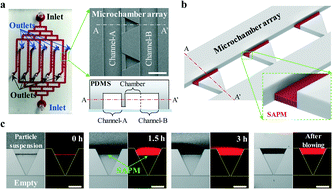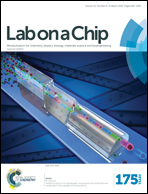Self-assembled particle membranes for in situ concentration and chemostat-like cultivation of microorganisms on a chip†
Abstract
Recently, microparticles have been used as nanoporous membranes in microfluidic devices, contributing to various bioassays on a chip. Here, we report a self-assembled particle membrane (SAPM) integrated microfluidic device that concentrates particles into an aimed microchamber array by using evaporation-driven capillary forces, and manipulates the chemical environment of the microchamber array by sequentially introducing different solutions. We demonstrate that the SAPM-integrated microchamber array can concentrate microparticles and microbial cells up to 120-fold for 2 h and 35-fold for 1 h, respectively, resulting in remarkably high concentration factors. Additionally, we demonstrate that the microchamber array has high potential as a chemostat-like bioreactor because it can actively manipulate the initial seeding number of bacterial cells and continuously supply and sequentially switch fresh nutrients to them. As an example of various applications, the chemostat-like bioreactor was used as a microbial biosensor platform that enabled microbial sensor cells to respond more efficiently and rapidly to external stimuli, such as heavy metal ions. This was made possible by almost eliminating the initial lag phase that dramatically shortened the whole assay time. Notably, the SAPM-integrated microchamber array not only facilitates various bioassays on a chip but also provides unprecedented experimental platforms to study microorganisms in a simple and convenient manner.


 Please wait while we load your content...
Please wait while we load your content...